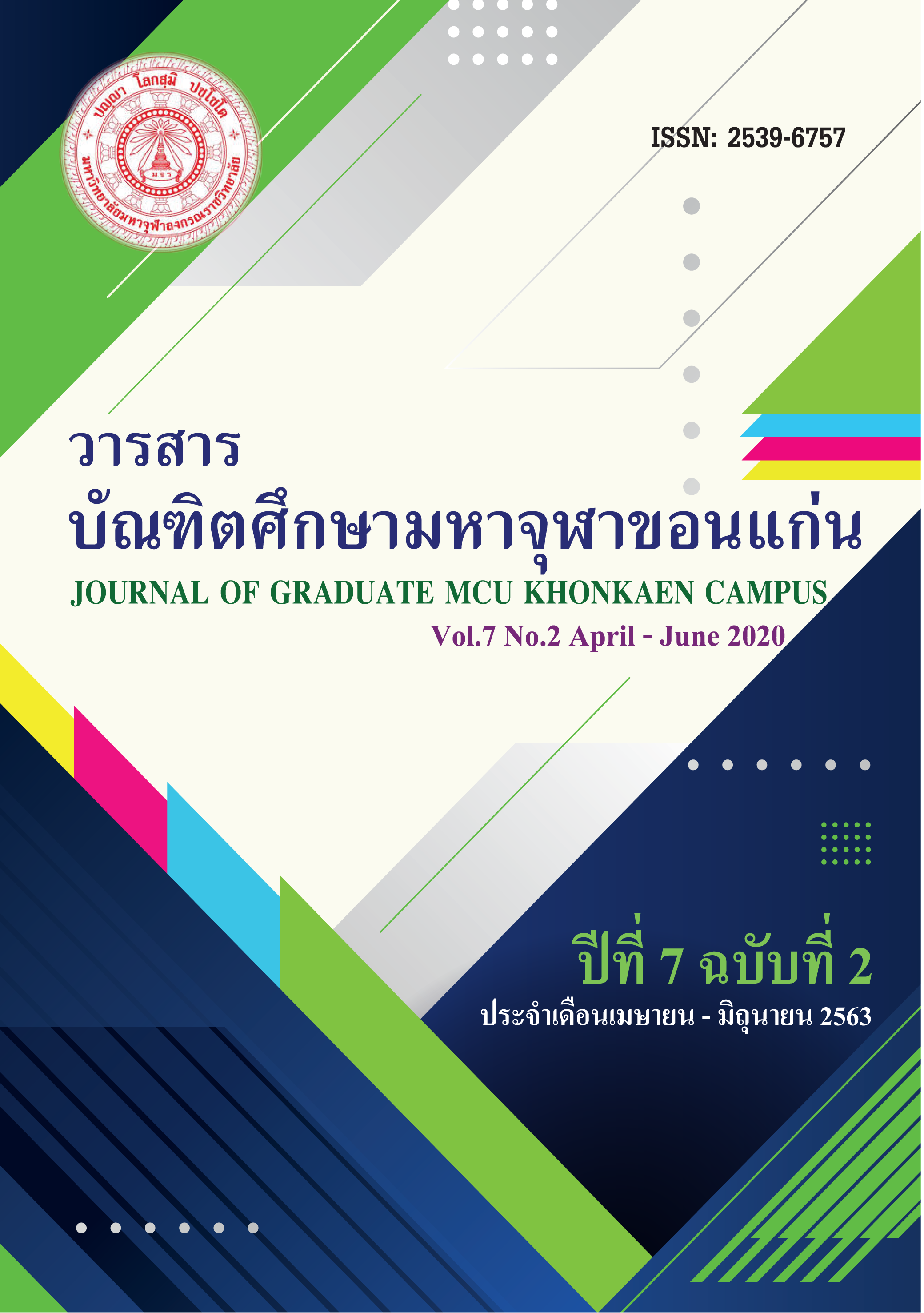การวิเคราะห์หนังสือเรียนรายวิชาภาษาไทย ระดับมัธยมศึกษาตอนปลาย
Main Article Content
บทคัดย่อ
บทคัดย่อ
หนังสือเรียนเป็นสื่อการเรียนรู้สำหรับครูและนักเรียน การวิเคราะห์หนังสือเรียนจะทำให้ครูเข้าใจลักษณะของหนังสือเรียนและสามารถใช้หนังสือเรียนในการจัดการเรียนรู้ได้อย่างมีคุณภาพ การวิจัยครั้งนี้มีวัตถุประสงค์เพื่อวิเคราะห์หนังสือเรียนรายวิชาภาษาไทย ระดับมัธยมศึกษาตอนปลาย การวิจัยครั้งนี้เป็นการวิจัยเชิงคุณภาพ (Qualitative research) กลุ่มเป้าหมายที่ทำการวิจัย คือ หนังสือเรียนภาษาไทย หลักภาษาและการใช้ภาษาเพื่อการสื่อสารและวรรณคดีวิจักษ์ ระดับมัธยมศึกษาตอนปลาย เครื่องมือที่ใช้ในการวิจัย ได้แก่ 1) หนังสือเรียนรายวิชาภาษาไทย ระดับมัธยมศึกษาตอนปลาย และ 2) แบบบันทึกการวิเคราะห์หนังสือเรียนรายวิชาภาษาไทย 4 ด้าน ประกอบด้วย การวิเคราะห์จุดประสงค์การเรียนรู้ (KPA) การวิเคราะห์คุณลักษณะอันพึงประสงค์การวิเคราะห์สมรรถนะสำคัญของผู้เรียน และการวิเคราะห์ทักษะการเรียนรู้ของผู้เรียนศตวรรษที่ 21 สถิติที่ใช้ในการวิเคราะห์ข้อมูล ได้แก่ ค่าเฉลี่ยร้อยละ ผลการวิจัยพบว่า 1) ด้านจุดประสงค์การเรียนรู้พบทั้ง 3 ด้าน โดยพบด้านความรู้มากที่สุด คิดเป็นร้อยละ 47 ด้านทักษะ คิดเป็นร้อยละ 40 และด้านคุณลักษณะอันพึงประสงค์ คิดเป็นร้อยละ 13 2) ด้านคุณลักษณะอันพึงประสงค์ พบทั้งหมด 4 ข้อ คือ พบข้อที่ 6 มุ่งมั่นในการทำงานมากที่สุด คิดเป็นร้อยละ 48 ข้อที่ 4 ใฝ่เรียนรู้ คิดเป็นร้อยละ 47 ข้อที่ 7 รักความเป็นไทย คิดเป็นร้อยละ 3 และข้อที่ 1 รักชาติ ศาสน์ กษัตริย์ คิดเป็นร้อยละ 2 3) ด้านสมรรถนะสำคัญของผู้เรียน พบทั้งหมด 4 ข้อ คือ ข้อที่ 1 ความสามารถในการสื่อสาร คิดเป็นร้อยละ 54 ข้อที่ 2 ความสามารถในการคิด คิดเป็นร้อยละ 39 ข้อที่ 4 ความสามารถในการใช้ทักษะชีวิต คิดเป็นร้อยละ 6 และข้อที่ 3 ความสามารถในการแก้ปัญหา คิดเป็นร้อยละ 1 4) ด้านทักษะการเรียนรู้ของผู้เรียนในศตวรรษที่ 21 พบทั้ง 3 ทักษะ คือ พบด้านคุณลักษณะคนในศตวรรษที่ 21 มากที่สุด คิดเป็นร้อยละ 43 ลำดับต่อมาคือ ทักษะเพื่อการดำรงชีวิตในศตวรรษที่ 21 คิดเป็นร้อยละ 48 และลำดับสุดท้ายคือทักษะการรู้สาระเนื้อหา คิดเป็นร้อยละ 9
Article Details
เอกสารอ้างอิง
วรพจน์ วงศ์กิจรุ่งเรือง และ อธิป จิตตฤกษ์. (2554). ทักษะแห่งอนาคตใหม่ : การศึกษาเพื่อศตวรรษที่ 21 แปลจาก 21st Century Skills: Rethinking How Students Learn. แหล่งที่มา:
http://openworlds.in.th/books/21st-century-skills/.
สำนักงานคณะกรรมการการศึกษาขั้นพื้นฐาน. (2551). แนวดำเนินงานของคณะกรรมการเขตพื้นที่การศึกษาและคณะกรรมการสถานศึกษาขั้นพื้นฐาน. กรุงเทพฯ: ครุสภา.สำนักวิชาการและมาตรฐานการศึกษา,สำนักงานคณะ
กรรมการการศึกษาขั้นพื้นฐาน
กระทรวงศึกษาธิการ. (2549). หนังสือเรียนรายวิชา พื้นฐาน ภาษาไทย ชั้นมัธยมศึกษาปีที่ 4 หลักภาษาและการใช้ภาษาเพื่อการสื่อสาร. กรุงเทพฯ:
โรงพิมพ์ สกสค.ลาดพร้าว.
. (2549). หนังสือเรียนรายวิชา พื้นฐาน ภาษาไทย ชั้นมัธยมศึกษาปีที่ 5 หลักภาษาและการใช้ภาษาเพื่อการสื่อสาร. กรุงเทพฯ: โรงพิมพ์ สกสค.ลาดพร้าว.
. (2549). หนังสือเรียนรายวิชา พื้นฐาน ภาษาไทย ชั้นมัธยมศึกษาปีที่ 6 หลักภาษาและการใช้ภาษาเพื่อการสื่อสาร. กรุงเทพฯ: โรงพิมพ์ สกสค.ลาดพร้าว.
. (2549). หนังสือเรียนรายวิชา พื้นฐาน ภาษาไทย ชั้นมัธยมศึกษาปีที่ 4 วรรณคดีวิจักษ์ กรุงเทพฯ: โรงพิมพ์ สกสค.ลาดพร้าว.
. (2549). หนังสือเรียนรายวิชา พื้นฐาน ภาษาไทย ชั้นมัธยมศึกษาปีที่ 5 วรรณคดีวิจักษ์ กรุงเทพฯ: โรงพิมพ์ สกสค.ลาดพร้าว.
. (2549). หนังสือเรียนรายวิชา พื้นฐาน ภาษาไทย ชั้นมัธยมศึกษาปีที่ 6 วรรณคดีวิจักษ์ กรุงเทพฯ: โรงพิมพ์ สกสค.ลาดพร้าว.
สิริวรรณ ศรีพหล. (2555). รายงานการวิจัย เรื่อง การพัฒนาชุดฝึกอบรมทางไกลสำหรับครูสังคมศึกษาเรื่องการจัดการเรียนการสอนการพัฒนาชุดฝึกอบรมทางไกล
สำหรับสถานศึกษา เรื่อง การจัดการเรียนการสอนเพื่อพัฒนาคุณธรรม จริยธรรมให้กับผู้เรียนตามหลักปรัชญาของเศรษฐกิจพอเพียง. งบประมาณแผ่นดิน ประจำปี 2553 มหาวิทยาลัยสุโขทัยธรรมาธิราช.
Benjamin S. Bloom. (1956). Benjamin S. Bloom: Portraits of an Educator. Thomas R. Guskey.
Lorin Anderson และ Krathwohl. (2001). Instructional Patterns: Strategies for Maximizing Student Learning. Larry C. Holt, Marcella Kysilka,
Marcella L. Kysilka.

